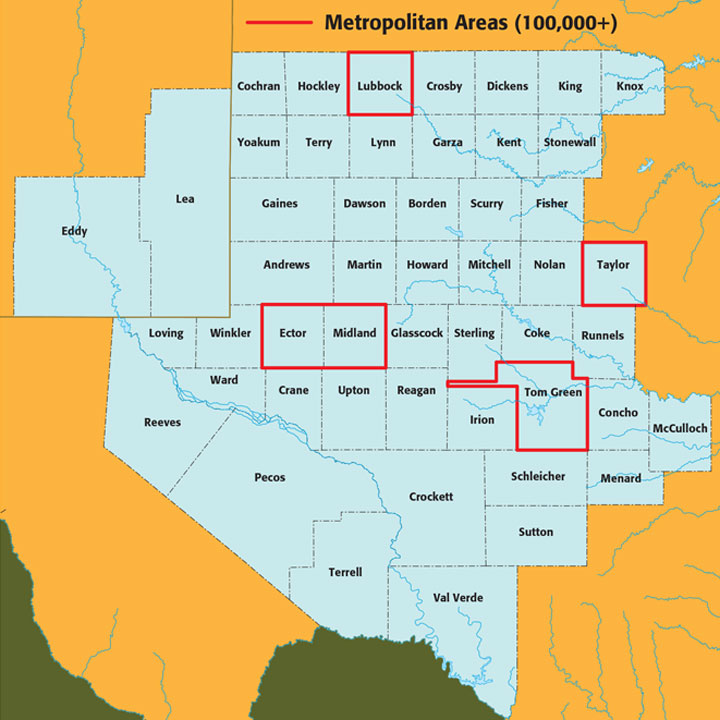Fossil-Based Energy

The Permian Basin, located in West Texas and the adjoining area of southeastern New Mexico, is the largest oil-and-gas-producing area in the U.S. It covers an area approximately 250 miles wide and 300 miles long and is composed of more than 7,000 producing oil-and-gas fields. It has been producing oil and gas since 1920 and, as of 2018, has produced more than 33 billion barrels of oil and 118 trillion cubic feet of natural gas. Estimated proven reserves in the Permian Basin are still more than 46 billion barrels of oil and more than 260 trillion cubic feet of natural gas.
The U.S. consumes 7.5 billion barrels of oil and 31 trillion cubic feet of gas a year. Currently, 69% of the U.S. energy needs come from oil and gas. Nuclear, coal and renewables make up about 10% each. However, oil and gas are more than energy. They are used for the building blocks for every day products used in cars, homes, clothes, pharmaceuticals and almost everything you encounter.
1/3 of the world's population suffers from energy poverty and oil and gas are the most portable form of clean energy that can solve this poverty in the near term. Texas Tech is not only looking for ways to produce oil and gas in a more environmentally cleaner way but is also researching methods to store captured CO2 in a clean and safe manner. Natural Gas is responsible for the reduction of carbon emissions in the U.S. and emits 50-60% less CO2 than coal-fired plants. Additionally, hydrogen is seen by many as the next generation's fuel and generates no greenhouse gases upon combustion.
Strengths
Texas Tech researchers have strong research interests in the following areas:
- Reserves and economics for both Oil & Gas and CCUS (Carbon Capture, Utilization, and Storage)
- Production optimization and artificial lift
- Brownfields development
- Wellbore integrity, cementing and hydraulics in horizontal wells, fracturing
- Hydraulic fracturing
- Rock mechanics for seals in CO2/H2 storage reservoirs
- Enhanced Oil Recovery (CO2 Flooding, Solvent Injection, etc.)
- Development of unconventional resources
- Well-testing analysis
- Reservoir simulation
- Reservoir management
- CO2 sequestration
- Uncertainty analysis in basin and petroleum systems modeling,
- Single and multiphase flows in subsurface porous media,
- Hydrodynamic instabilities, experiments, and mathematical modeling
- Calibration of effective reservoir properties using fine-scale heterogeneous models for conventional and unconventional reservoirs
- Modeling of flow and pressure in fractures shale and tight reservoirs
- Simulation and process automation applied to history matching and optimization
- Sampling and updating methodologies for multi-parameter optimization.
Infrastructure & Facilities
- The Terry Fuller Petroleum Engineering Research Building on the Engineering Key was completed in 2014 and includes more than 42,000 square feet of modern classrooms, cutting-edge laboratories, and administrative space. The facility assists with the recruitment of students and faculty to further advance the field of petroleum engineering at Texas Tech.
- The Oilfield Technology Center (OTC) was completed in 2017: a 10-acre teaching and research facility located on Texas Tech property 15 minutes from campus. It has a 4,000 square-foot building, three test wells (one of which is 4,000 feet deep), tank batteries, gas facilities, and a functional modern drilling rig. Texas Tech is the only university in the country with a facility like this.
- Wellbore Integrity Lab (key in the long-term containment of CO2): proven successfully on multiple projects.
- The Rock Mechanics lab: world class, enabling us to assess reservoir seals for storage of Carbon or Hydrogen.
- Multiple EOR labs give insights as to how to maximize recovery in existing fields and combine EOR with CCUS.
- Texas Tech is leading the Texas Produced Water Consortium (established by state legislature 2021) as the host university.
Texas Tech University Energy Institute
-
Address
3311 18th Street, Lubbock, Texas 79409-0004 -
Phone
806-834-3178 -
Email
william.keffer@ttu.edu

 Counties in the Permian Basin. click to enlarge.
Counties in the Permian Basin. click to enlarge.